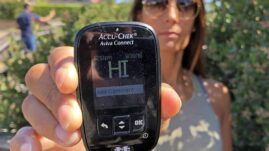If you live with diabetes, you know that managing your blood sugars within a tight range can be difficult.
Especially if you’re struggling to decipher between what hyperglycemia (high) and hypoglycemia (low) blood sugars feel like.
Even more confusingly, the symptoms of both conditions can be very similar.
So how do you tell the difference between high and low blood sugars?
This article will describe both hyperglycemia and hypoglycemia, their symptoms, and how to tell the difference between the two when it matters most.

Table of Contents
What is hyperglycemia?
Hyperglycemia is also known as high blood sugar, and that means that one’s blood glucose is higher than normal. This can happen in people both with and without diabetes.
Normal blood sugar levels can vary, but the blood sugar levels in someone without diabetes after fasting (no food for at least 2 hours) is typically 99 mg/dL or lower.
100-125 mg/dL indicates prediabetes, and anything over 125 mg/dL while fasting indicates diabetes.
For people without diabetes, hyperglycemic episodes are short-lived.
However, people with diabetes typically need to either exercise or take a prescribed medication to bring their blood sugar levels down.
People with diabetes can have blood sugar levels go extremely high, and when this happens, it can turn into diabetic ketoacidosis (DKA), which can become life-threatening if not treated.
What are the causes of hyperglycemia?
For people without diabetes, a blood sugar higher than normal is usually caused by eating something sugary or from medications like steroids.
For people with diabetes, high blood sugar is the direct result of too little or no endogenous insulin (the insulin the pancreas makes) in the bloodstream.
Having diabetes means that your default blood sugar will always be high without proper medications to bring it down.
Acute hyperglycemic episodes can be caused by:
- Eating too many grams of sugar or carbohydrates with too little insulin or medication
- Not getting enough exercise
- Being sick or suffering from an infection
- Experiencing insulin resistance
- Being stressed
- Getting too little sleep
- Certain medications
- Dehydration
In fact, over 42 different variables can cause blood sugar changes in people with diabetes.
What are the symptoms of hyperglycemia?
The symptoms of hyperglycemia are the very same that many people experience upon being diagnosed with diabetes and they include but are not limited to:
- Extreme thirst
- Dry mouth
- Frequent urination
- Fruity-smelling breath
- Fatigue
- Headache
- Bodyache
- Blurry vision
- In extreme cases, weight loss
- In extreme and prolonged cases, the inability to heal from infections
- In extreme cases, DKA
If you’re experiencing any of these symptoms and have existing diabetes, check for ketones immediately and seek medical attention.
If you’re experiencing any of these symptoms and have not been diagnosed with diabetes, call your doctor right away to be tested for diabetes.
What is hypoglycemia?
Hypoglycemia is also known as low blood sugar.
This happens when there is too little glucose in the bloodstream for the body to properly function.
This can happen in people both with and without diabetes.
Low blood sugar levels can vary. However, anything lower than 70 mg/dL is considered low in people both with and without diabetes.
People who are experiencing low blood sugar will require any form of glucose (sugar) to bring their blood sugars back into a normal range.
For a low blood sugar level that’s not severe, eating between 15-20 grams of carbohydrates will bring someone back into a normal range, but that varies by person.
Check with your doctor if you’re unsure of how many carbohydrates you will require to treat a typical low blood sugar level.
It’s more common to experience severe low blood sugar if you take exogenous insulin(insulin injected or taken via an insulin pump.)
Your liver will typically dump glucose into the bloodstream to prevent a catastrophic low.
If someone with diabetes is experiencing severely low blood sugar and their liver fails to do this, they will require an injection of the hormone glucagon (available in a pen or inhaler.)
This will trigger their liver to release glucose into the bloodstream and can be life-saving.
Unfortunately, as many as 25% of people with type 1 diabetes (and many with type 2 diabetes) have hypo unawareness where they cannot detect their low blood sugars.
What are the causes of hypoglycemia?
In people without diabetes, hypoglycemia can be the result of fasting, eating too few carbohydrates, strenuous exercise, or being on certain medications.
In people with diabetes, hypoglycemia is the result of:
- Taking too much insulin or other diabetes medications
- Eating too few carbohydrates
- Drinking alcohol
- Changes in insulin regimen or medications
- Unexpected changes to your schedule
- Hot and humid weather
Even if you’re able to detect your low blood sugar level, it’s important to be able to recognize symptoms of a low blood sugar level before it becomes serious.
What are the symptoms of hypoglycemia?
Symptoms of low blood sugar can vary, but it typically includes:
- Shakiness
- Sweating
- Confusion
- Fatigue
- Fast heartbeat
- Dizziness
- Hunger
- Anxiety
- In extreme cases, diabetic coma
- If extreme cases, death
How can I tell the difference between high and low blood sugar levels?
In some cases, the symptoms of high and low blood sugar levels can mimic each other, especially if it occurs overnight when you’re not as alert and awake.
Feelings of confusion and fatigue affect people when their blood sugar levels are both high and low.
However, feeling lethargic and experiencing muscle aches are classic high blood sugar symptoms.
Feeling jittery and nervous with a rapid heartbeat and sweats are classic low blood sugar symptoms.
If you’re having trouble deciphering between the two, wearing a continuous glucose monitor (CGM) can be helpful, especially for overnight blood sugar levels.
If you choose (or cannot) not to wear a CGM, testing your blood sugar frequently can confirm the symptoms you’re experiencing.
Additionally, if you struggle with hypo unawareness, getting a diabetes alert dog (DAD) that is trained to detect both high and low blood sugar levels can help you detect and treat these episodes before they become medical emergencies.
Many people are unable to detect the difference between low, normal, and high blood sugar levels if their diabetes management has become loose, or they do not have very tight control of their blood sugar levels.
By keeping a closer watch on blood sugar levels, and treating higher blood sugars more aggressively, you will start to feel the symptoms of hyperglycemia earlier.
The same advice applies to low blood sugar levels.
If you start treating your hypoglycemic episodes when your blood sugar hits 80 mg/dL instead of 70 mg/dL, you may start to feel when your blood sugar is nearing 80 mg/dL instead of not experiencing any symptoms at all until your blood sugar level is at a much more dangerous 60 mg/dL.
Talk with your doctor if you’re concerned that you may not be feeling your highs and lows, and see what recommendations they may have for you.
Prevention
It is best to prevent both high and low blood sugars as much as possible. Keep a close watch on your blood sugar levels, and treat both highs and lows before they become problematic.
Take all your diabetes medications as prescribed, and try to manage sleep, physical activity, diet, and stress in a healthy way.
Keep a food journal, especially if you’re having trouble with high or low blood sugar levels after meals, and make notes of how you’re feeling after you eat certain foods or do certain activities.
Try and do what works best for you and your diabetes management.
Maintain consistency when it comes to the timing of your exercise and activities, meals, and medications.
Seek support from family and friends, and be vocal with your doctor about what’s working (and what’s not) when it comes to your diabetes management.
Remember, it’s your life, and if something isn’t working, you’re always allowed (and encouraged) to change it!
Conclusion
People both with and without diabetes can experience hyperglycemia (high) and hypoglycemia (low) blood sugar levels.
Fasting high blood sugar levels for someone without diabetes is anything over 99 mg/dL and high fasting blood sugar levels for someone with diabetes is anything over 125 mg/dL.
Low blood sugar levels for someone both with and without diabetes is anything under 70 mg/dL.
There are many different causes for high and low blood sugar levels, but for people with insulin-dependent diabetes, it is usually a matter of taking too much insulin (low blood sugar) or too little insulin (high blood sugar).
Both levels can be dangerous to one’s health, so it’s important to notice the symptoms of each and act accordingly.
Symptoms of high blood sugar include thirst, frequent urination, muscle aches, and fatigue.
While symptoms of low blood sugar include shakiness, nervousness, sweating, and fatigue.
Several of the symptoms of low and high blood sugars overlap, so it’s important to manually check your blood sugar levels often to confirm any symptoms you’re experiencing.
Additionally, you may find it helpful to use a continuous glucose monitor (CGM). If you struggle with hypo unawareness, use a diabetes alert dog (DAD) who can sense high and low blood sugar levels.
Taking preventive measures to avoid dangerously high and low blood sugar levels is key.
Always take your medications as prescribed, carry snacks to treat low blood sugar, keep to a schedule, and try to create a healthy sleep, stress management, and exercise routine.
Talk with your doctor about any concerns you may have about frequent low and high blood sugar levels and how to help treat and prevent them.



